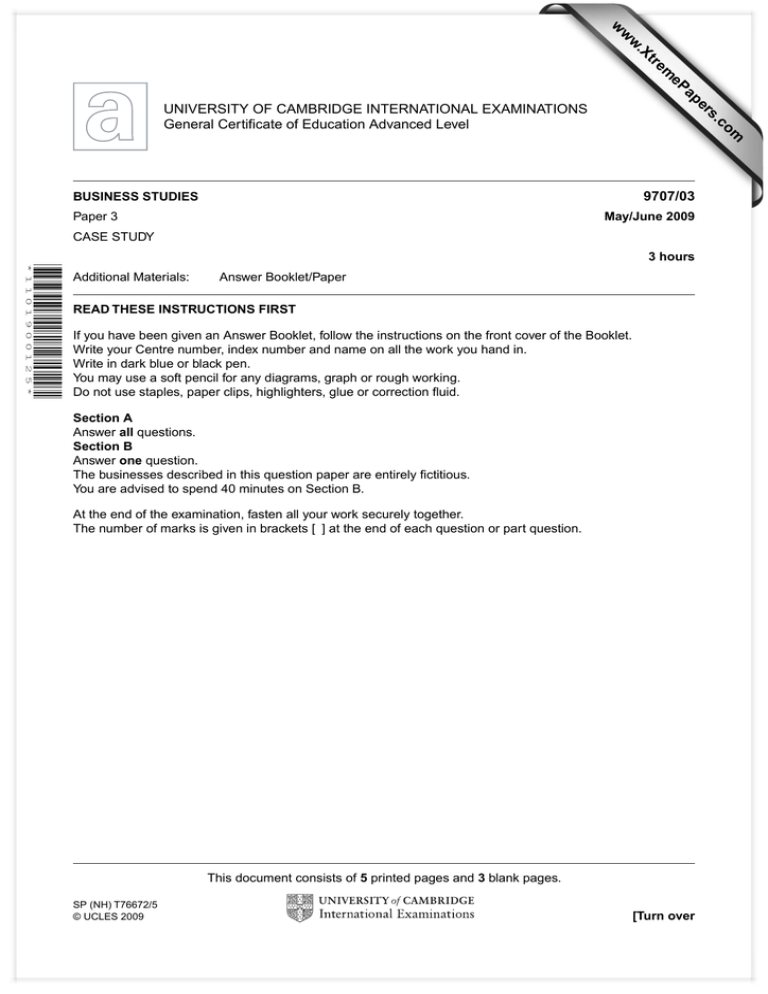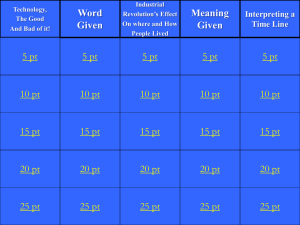www.XtremePapers.com UNIVERSITY OF CAMBRIDGE INTERNATIONAL EXAMINATIONS General Certificate of Education Advanced Level 9707/03
advertisement

w w ap eP m e tr .X w om .c s er UNIVERSITY OF CAMBRIDGE INTERNATIONAL EXAMINATIONS General Certificate of Education Advanced Level 9707/03 BUSINESS STUDIES Paper 3 May/June 2009 CASE STUDY 3 hours *1101900125* Additional Materials: Answer Booklet/Paper READ THESE INSTRUCTIONS FIRST If you have been given an Answer Booklet, follow the instructions on the front cover of the Booklet. Write your Centre number, index number and name on all the work you hand in. Write in dark blue or black pen. You may use a soft pencil for any diagrams, graph or rough working. Do not use staples, paper clips, highlighters, glue or correction fluid. Section A Answer all questions. Section B Answer one question. The businesses described in this question paper are entirely fictitious. You are advised to spend 40 minutes on Section B. At the end of the examination, fasten all your work securely together. The number of marks is given in brackets [ ] at the end of each question or part question. This document consists of 5 printed pages and 3 blank pages. SP (NH) T76672/5 © UCLES 2009 [Turn over 2 CAR MANUFACTURER AT A CROSSROADS Introduction Eastern Motors (EM) is a public limited company that manufactures cars in eight factories. It makes and sells cars with brand names that are well known worldwide. The company’s main products are family cars that are sold to mass markets at competitive prices. Marketing of EM cars EM’s cars are sold in 35 countries. The company does not operate its own retail outlets. It sells all of its cars through independent agents. There are several benefits of this. EM does not have to obtain detailed market knowledge of each country its products are sold in. It leaves this to each country’s agent. Selling cars to consumers is the responsibility of these agents and they also bear the significant cost of stock holding cars. 5 10 EM is planning to start selling its cars in Country Z for the first time. The Marketing Director plans to open an EM owned car retailing business in Country Z. ‘For the first time we will have complete control over the marketing strategies for our cars’ she told her sales team. Environmental pressures The challenge of climate change is having an impact on governments and consumers all over the world. Some governments are increasing taxes on the most polluting and powerful cars. Pressure groups in some countries are encouraging buyers to move away from buying big cars towards purchasing smaller cars using fuels other than petrol – such as hybrid cars. This attempt to change consumer buying habits is being supported by some famous film actors selling their big and environmentally damaging cars and buying hybrid cars instead which are powered by petrol and electricity. Main competitors Asiatic Cars and Western Vehicles are EM’s main rivals. These companies used to only sell cars in similar market segments to EM, but they now also produce larger and more powerful models and fast sports cars. These types of cars sell for prices, on average, 25% higher than EM’s cars. Both companies use more extensive above and below the line promotion than EM. In addition, Asiatic Cars and Western Vehicles have recently started to obtain raw materials, steel and other supplies from low labour cost countries and this has reduced their costs of production. Eastern Motors’ profit margins on the decline Although EM’s total profits have remained steady in recent years, profit margins have fallen. Data to support this is shown in Appendix A – together with an inter-firm comparison with its two main rivals. EM directors are very worried about these declining profit margins. They believe that they result from increased competition and over-capacity in the world car industry. The recent rapid growth of multinational car manufacturers and free international trade has forced car prices down. EM’s Marketing Director reported at a recent international car exhibition that ‘Increased opportunities for investment by multinational car companies will create more threats than opportunities for EM’. All EM directors are agreed that the trend in falling profit margins must be reversed. If the trend continues, total profits will eventually fall. This will mean that any future expansion will be likely to need external finance to pay for it. © UCLES 2009 9707/03/M/J/09 15 20 25 30 35 40 3 Human resources problem Appendix B refers to employee performance data in the eight EM factories. The Northcape factory was only opened two years ago in a low income country with few legal controls over employee welfare. In an attempt to cut costs, EM introduced a different management and motivational strategy within the Northcape factory compared with all its other factories. The Human Resources director has been trying to find out why the employees in this factory seem to perform less effectively than in the other EM factories. ‘If we can increase productivity and reduce wastage and absenteeism in the Northcape factory then this will make us more competitive.’ 45 50 Strategies for the future ‘No business can stand still for long’ announced the Chief Executive at a recent board meeting. ‘The mass market for cars is changing. Consumers want much more variety and car models that suit their incomes and life styles. We should start making luxury cars and sports cars. Look at the data I have produced.’ (See Appendix C.) ‘It shows our sales performance compared to our main rivals. I also have data on Research and Development spending. It is my belief that if we increased spending on technological research into new types of engines and car designs we would be certain to increase our sales and profits very quickly. Research and Development spending always creates innovative products and increases profits.’ 55 Appendix A: Data for Eastern Motors 2008 $m 60 Sales revenue Gross profit Net profit 16 350 3600 1520 Inter-firm comparison between EM and two rival car manufacturers Eastern Motors Asiatic Cars Western Vehicles Gross profit margin % Net profit margin % Gross profit margin % Net profit margin% Gross profit margin % Net profit margin % 2006 35 16 37 20 42 23 2007 32 12 34 20 40 22 2008 – – 30 15 36 20 © UCLES 2009 9707/03/M/J/09 65 [Turn over 4 Appendix B: EM Employee and output data 2008 70 Northcape Factory Other EM factories Number of workers employed 5500 5000 (average) Number of workers leaving during the year 1000 750 (average) Proportion of workers who left during year (labour turnover) See question 2(a) 15% 385 000 450 000 (average) Output of cars per worker (labour productivity) See question 2(a) 90 Wastage rate as % of total output 7 5 (average) 27 500 15 000 (average) No Yes Piece rate Salary No Yes 15% of workers 90% of workers Total output of cars Annual days lost through absenteeism Team working Pay system Quality circles used Full-time, permanent contracts 75 80 85 Appendix C: Sales and market data and spending on Research and Development • • • In 2008, world demand for family cars increased by 5%. World demand for luxury and sports cars increased by 9%. Annual world economic growth is forecast to fall from 6% to 3% for the period 2009–2012. EM Asiatic Cars Western Vehicles 2008 Sales growth (number of cars) 8% 16% 11% 2008 Sales growth (value of sales) 2% 15% 8% Number of different car models sold 8 16 12 $0.5bn $2bn $4bn Research and Development spending 2008 © UCLES 2009 9707/03/M/J/09 90 95 5 Section A Answer all questions in this section. 1 Assume Eastern Motors has a factory in your country. Analyse the impact of any two legal controls on this factory’s operations. [8] 2 (a) Using data from Appendix B, calculate for the Northcape factory in 2008: (i) The proportion of workers who left [2] (ii) Output of cars per worker. [2] (b) ‘If we can increase productivity and reduce wastage and absenteeism in the Northcape factory then this will make us more competitive.’ (lines 48–50) Recommend an appropriate Human Resources strategy to achieve this objective. Support your recommendation. [16] 3 To what extent do you agree with the Chief Executive when he states that ‘Research and Development spending always creates innovative products and increases profits’? (lines 58–59) [16] 4 (a) Using data from Appendix A, calculate the following ratios for EM in 2008: 5 (i) Gross profit margin [3] (ii) Net profit margin. [3] (b) Analyse two possible reasons for EM’s falling gross profit margin. [6] (c) Evaluate any two ways in which EM might increase its net profit margin. [8] Recommend whether EM should set up and operate its own car retailing business in Country Z. Justify your recommendation. [16] Section B Answer one question in this section. 6 In your opinion, should EM go ahead with the plan to start producing luxury and sports cars for sale in new market segments? Justify your decision. [20] 7 ‘Increasing opportunities for multinational investment by car manufacturers will create more threats than opportunities for EM.’ (lines 37–38) To what extent do you agree with this statement? [20] © UCLES 2009 9707/03/M/J/09 6 BLANK PAGE 9707/03/M/J/09 7 BLANK PAGE 9707/03/M/J/09 8 BLANK PAGE Permission to reproduce items where third-party owned material protected by copyright is included has been sought and cleared where possible. Every reasonable effort has been made by the publisher (UCLES) to trace copyright holders, but if any items requiring clearance have unwittingly been included, the publisher will be pleased to make amends at the earliest possible opportunity. University of Cambridge International Examinations is part of the Cambridge Assessment Group. Cambridge Assessment is the brand name of University of Cambridge Local Examinations Syndicate (UCLES), which is itself a department of the University of Cambridge. 9707/03/M/J/09




